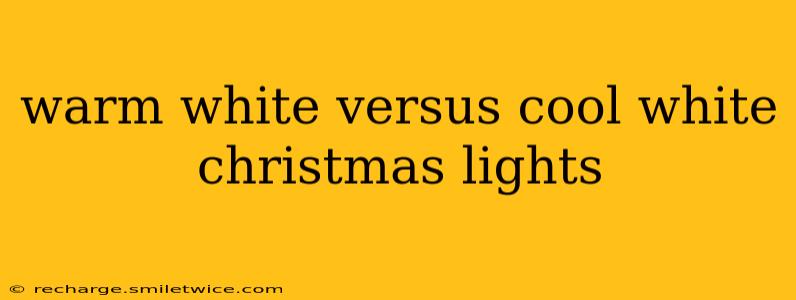Choosing the right Christmas lights can significantly impact the overall ambiance of your holiday décor. The seemingly simple decision between warm white and cool white lights can dramatically alter the mood, making the selection process more important than you might initially think. This comprehensive guide will delve into the key differences between warm white and cool white Christmas lights, helping you make an informed choice for your festive display.
What is the Difference Between Warm White and Cool White Christmas Lights?
The core difference lies in the color temperature, measured in Kelvin (K). Warm white lights have a lower color temperature, typically ranging from 2700K to 3000K. This results in a yellowish, amber, or even slightly orange hue, reminiscent of traditional incandescent bulbs. Conversely, cool white lights boast a higher color temperature, usually between 5000K and 6500K, producing a brighter, crisper white light with a slightly bluish tint. Think of the difference between candlelight (warm) and daylight (cool).
Which Color Creates a Warmer, More Traditional Feel?
Warm white lights undeniably create a warmer, more traditional Christmas feel. Their soft, inviting glow evokes feelings of nostalgia and comfort, perfectly complementing classic holiday decorations and creating a cozy atmosphere. This is the choice for those seeking a romantic, vintage, or rustic ambiance.
What is the difference in the brightness of warm white versus cool white lights?
While the perceived brightness can be subjective and dependent on the wattage and number of bulbs, cool white lights generally appear brighter than warm white lights. This is because their higher color temperature emits more light in the blue spectrum, which our eyes perceive as brighter. However, the intensity of brightness depends more on the total wattage and the number of lights used, not solely on the color temperature.
Are cool white Christmas lights better for outdoor use?
This is a common misconception. Both warm white and cool white lights are suitable for outdoor use, provided they are rated for outdoor use (look for the appropriate IP rating). The choice depends entirely on your personal preference and the overall aesthetic you want to achieve. Cool white lights might be preferred for visibility in areas with low ambient light, but warm white lights can still provide ample illumination.
What are the best Christmas lights for creating a festive atmosphere?
The "best" Christmas lights depend on your desired aesthetic. For a classic, cozy, and inviting atmosphere, warm white lights are the clear winner. If you prefer a modern, clean, and bright look, cool white lights might be a better option. Consider the overall style of your home and decorations when making your choice. Some people even mix both types for a varied effect!
Do warm white or cool white lights use less energy?
The energy consumption is primarily determined by the wattage of the bulbs, not the color temperature. LED lights, regardless of whether they're warm or cool white, are generally far more energy-efficient than traditional incandescent bulbs. Check the product specifications to compare energy usage.
What type of Christmas lights is best for a modern home?
Modern homes often benefit from the crisp, clean look of cool white lights. Their bright, contemporary feel aligns well with minimalist and sleek decorating styles. However, a touch of warm white can add inviting contrast. Ultimately, the best choice depends on your personal style.
In conclusion, the choice between warm white and cool white Christmas lights is a matter of personal preference and the desired atmosphere. Carefully consider the ambiance you want to create, your home's style, and the overall effect you wish to achieve before making your decision. Happy decorating!
